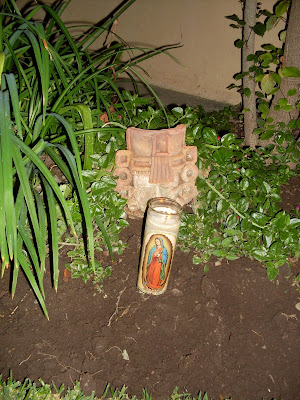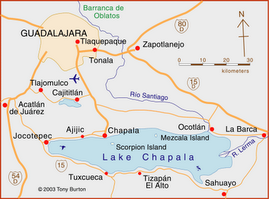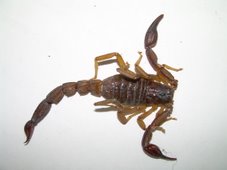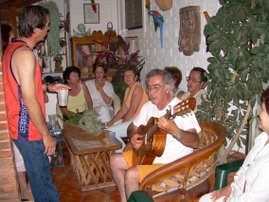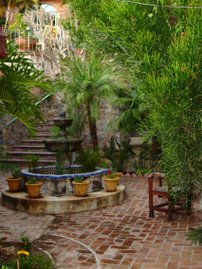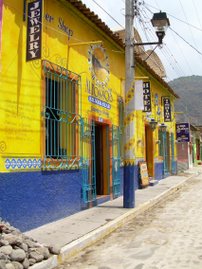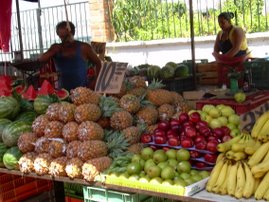 One of the common features of living in Mexico is the presence of domesticated animals everywhere. This herd of goats grazes at least once a week on our street, Santa Margarita. The owner of the goats seems to take them to various places around Riberas, the small community between Ajijic and Chapala, where we live. Mexicans enjoy goat meat, particularly in the common chili-based stew, birria. They graze on almost anything green and always seem to have a voracious appetite. Cows, or Vacas, are also common sights around the community. They are usually tied up grazing by the side of the road or enclosed in pastures. Because everything is so dry here, especially now, it can be a challenge finding good places for livestock to graze.
One of the common features of living in Mexico is the presence of domesticated animals everywhere. This herd of goats grazes at least once a week on our street, Santa Margarita. The owner of the goats seems to take them to various places around Riberas, the small community between Ajijic and Chapala, where we live. Mexicans enjoy goat meat, particularly in the common chili-based stew, birria. They graze on almost anything green and always seem to have a voracious appetite. Cows, or Vacas, are also common sights around the community. They are usually tied up grazing by the side of the road or enclosed in pastures. Because everything is so dry here, especially now, it can be a challenge finding good places for livestock to graze. Families often keep chickens as well. I can often see them walking around the yards of Mexican homes. Presumably they keep them for eggs and eventually for meat. Every morning we can hear a chorus of roosters who often don't wait for dawn to crow.
Horses are another ever-present sight throughout the community. It is common to see them tied up in front of homes or stores when we're in town. The Mexicans love to ride their horses around town, and some appear to use them as regular forms of transportation. We also see burros and donkeys. In the rural areas it is common to see old men in sombreros leading burros laden with firewood or some other cargo on dirt paths near the road.
This time of year, the American white pelicans have returned to their winter quarters here at Lake Chapala. They spend most of their time in the lake, fishing. The photo below is a common scene as the pelicans hang out with the Chapala fisherman who use the traditional fishing method of using a net. The pelicans are obviously hoping they will get some scraps.

These white pelicans are much larger than the brown pelicans we saw on the coast. (See the last post from Rincon de Guayabidos.) Apparently they are much more numerous on the south side of the lake where they tend to congregate. I rarely see more than a dozen at a time around here, although hundreds can be seen on the other side.
I thought I'd include some photos of the Ajijic tianguis, or outdoor market. Each town of any size in Mexico has one day set aside for their market. In fact, this practice is common around the world. We saw these local weekly markets when we were in Italy in 1999 as well. In Ajijic, the market is on Wednesdays. Chapala has its on Monday, and Jocotepec on Thursday. We generally go to the Ajijic market which appeals more to gringos with more craft and jewelry tables, English-language movies, and more bi-lingual vendors in general. We generally buy most of our fruits and vegetables for the week at the tianguis, as well as fresh yogurt, fish and shrimp, cheese, granola, and flowers. When you go every week, you get to know the vendors, and they know what you like, which makes shopping easier. It's more crowded now as the "snowbirds" have arrived, so shopping can take a bit more time. Here are some photos of last week's market.




Last Thursday, of course, was Thanksgiving, and we gathered, as usual, with our friends from our Unitarian Universalist fellowship at Lew and Trudy Crippen's house. Turkeys are not a popular food here in Mexico, and so they are expensive to get. Typically a 8-10 kilo turkey (18-22 pounds) will cost about $40US. At our Thanksgiving, the fellowship buys two turkeys, which Lew and Trudy cook, and we all bring the other fixin's. Pixie always makes her New England style cranberry sauce, and this year we also brought pumpkin pie and hot crab dip. As you can imagine we have a wide variety of foods, and we bring containers to bring home leftovers for the next day. It's a lovely dinner on their terrace overlooking the lake. Lew always puts a football game on in his den for those who want to watch, but most of us just eat, drink and talk.


One final photo. Our good friends, Steve and Susan Barr, welcomed their son, David, his wife Susan, and two of their children, Amelia and Kaitlyn, to Mexico for their first visit. They took them to Guadalajara to the zoo, to the Centro area, to Mescala Island, and all around the Lakeside area. Here they are when they stopped by for a visit at our house.





























